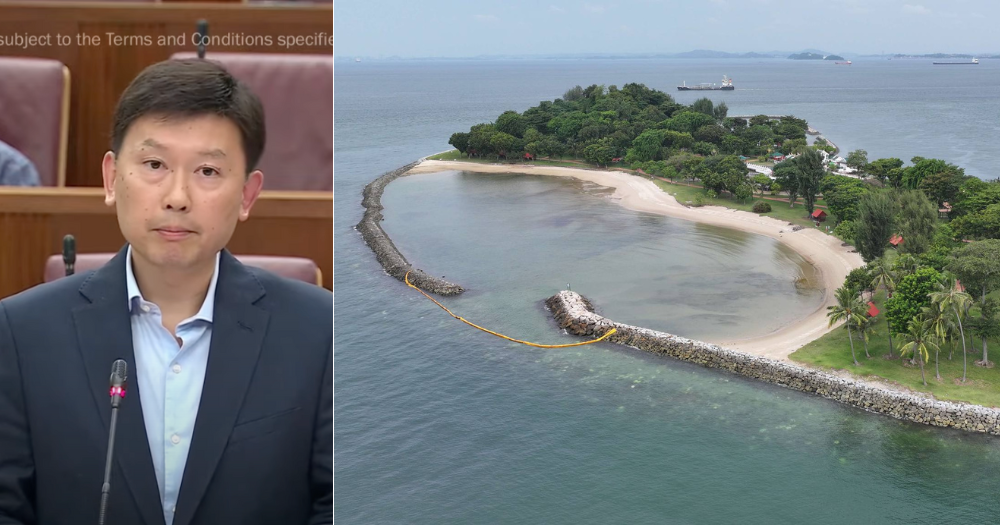 Speaking in parliament on Jul. 2, Minister for Transport Chee Hong Tat explained that while agencies try their best to reduce the risk of an oil spill happening in our waters, the risk of oil spills cannot be eliminated completely.
Speaking in parliament on Jul. 2, Minister for Transport Chee Hong Tat explained that while agencies try their best to reduce the risk of an oil spill happening in our waters, the risk of oil spills cannot be eliminated completely.
This was in response to questions from Members of Parliament (MPs) about possible measures to prevent oil spills in the future following the oil spill that happened on Jun. 14.
Chee also added that investigations into the oil spill are ongoing.
The preliminary findings showed that the allision was caused by the dredger's sudden loss of engine and steering controls.
Chee expressed his appreciation to the agencies, industry partners, and volunteers for "their hard work and the good progress made so far."
However, he added that there was still more work to complete the next clean-up phase and mitigate the oil spill's impact.
Chronology of the incident
Chee broke down the chronology of the oil spill and the steps taken.
The allision between the vessels happened on Jun. 14 at 2:18pm, and the Maritime & Port Authority (MPA) was notified at 2:22 p.m.
The first patrol craft arrived 11 minutes later at 2:33pm.
Once it was confirmed that a significant amount of oil had spilt into the water, the patrol craft sprayed dispersant in the surrounding areas.
Chee stated that this needed to be done quickly so the dispersant could break down the oil, which would facilitate subsequent cleaning operations at sea and on land.
11 more vessel from MPA and their contractors were deployed to perform different roles during the initial phase of the response on Jun. 14.
MPA also checked that the damaged vessel would not sink, that the crew was safe and that there was no further oil spillage.
MPA then activated T&T Salvage Asia to lay heavy-duty containment booms around the damaged vessel.
The T&T vessel arrived at 9:41pm on Jun. 14.
It took a few hours to load heavy equipment on board and another few hours to sail to the incident site.
T&T deployed over 200m of oil booms around the damaged vessel, which was completed by 5:15 a.m. on Jun. 15.
Why containment booms were not deployed immediately
Some MPs asked why MPA did not immediately deploy the containment booms onboard its patrol vessel while waiting for the T&T vessel to arrive to lay heavy-duty containment booms.
Chee pointed out that the booms onboard the MPA patrol vessel were lightweight oil containment booms unsuitable for dealing with the oil spill incident on Jun. 14.
That particular oil spill was more serious as it involved the sudden discharge of an estimated 400 tonnes of oil into the sea.
For such spills, the patrol vessel would focus on spraying dispersants and deploy contractors to lay heavy-duty oil containment booms around the damaged vessel as a preventive measure.
Chee added that this was the established procedure in line with international practice for dealing with oil spills.
Booms as preventive measure
Chee explained that the main purpose of the containment booms around the damaged vessel was not to "fence in" the spilt oil.
The containment booms were intended as a preventive measure in case of a further oil spill from the damaged vessel.
In addition, the containment boom could also help catch some of the oil which remained in the vicinity of the incident location.
"But this is not 100 per cent foolproof because the tidal currents and waves can carry the oil to go below or above the booms," said Chee.
Learning points
Chee said that while they do their best to reduce the risks of oil spills, it may still happen in Singapore's waters or the region.
As such, they have prepared for and maintained readiness to respond to such oil spills in "a prompt, coordinated and effective manner".
They have worked with industry partners to develop a contingency plan rehearsed and refined every two years during the inter-agency exercises for oil spills.
The standard operating procedures were enhanced along the way, which helped respond to the oil spill effectively.
"We will continue to update and improve our SOPs and contingency plans with learning points from this incident and prepare our teams to deal with oil spills effectively through training and regular inter-agency exercises."
Top photos via MCI/YouTube & MPA
If you like what you read, follow us on Facebook, Instagram, Twitter and Telegram to get the latest updates.


